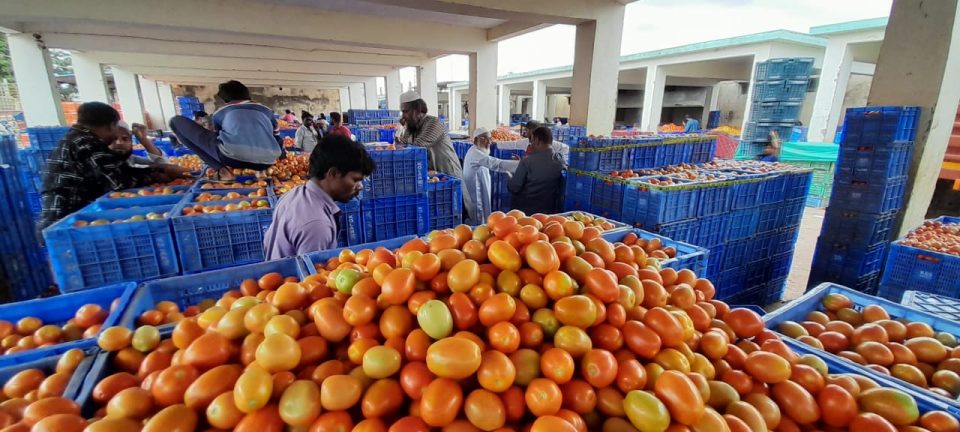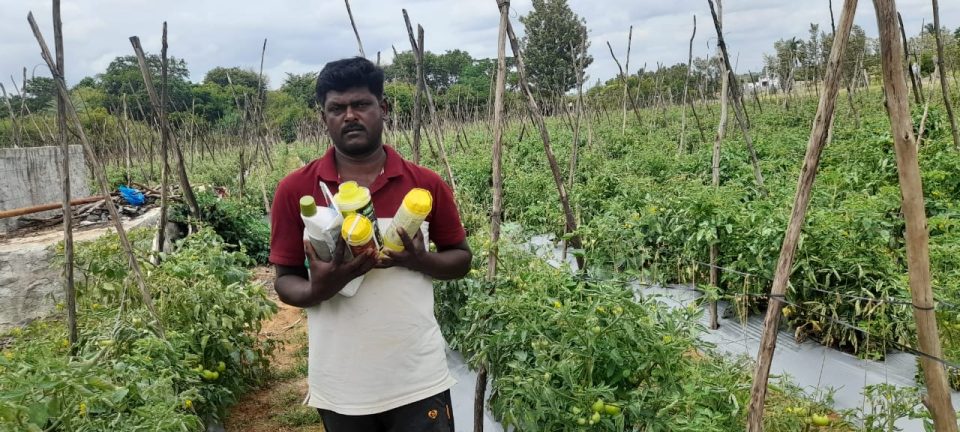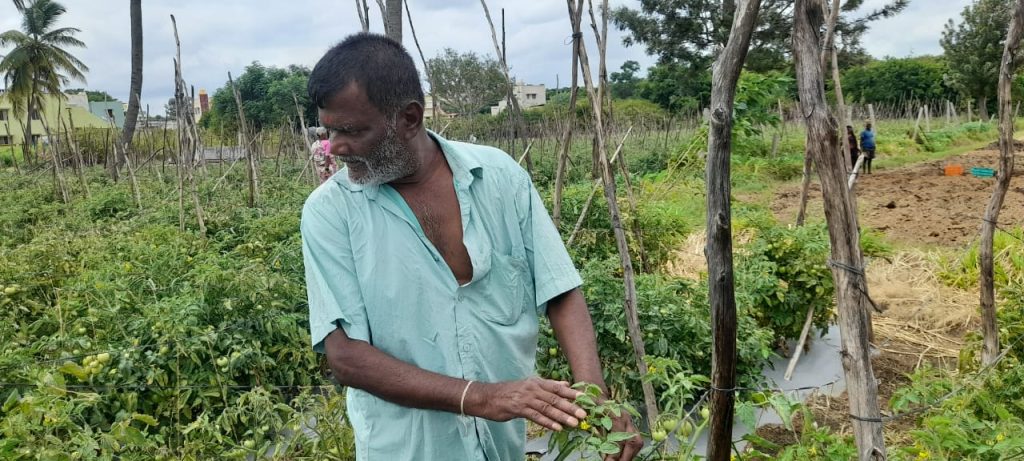
Ground report | Why tomato prices shot up in Kolar, and across India

The Kolar Tomato market, located in the Kolar Agricultural Produce & Livestock Market Committee (APMC) Yard, approximately 70km from Bengaluru, is second only to the Nashik (Pimpalgaon) tomato market. Spread over 25 acres, the Kolar tomato market has recorded an unprecedented price hike this year, in stark contrast to last year’s average price range of Rs 10 to Rs 20 per kg.
Since May, the prices have continued to rise steadily, with the current rate reaching Rs 2,000 per box (15 kg). Comparatively, the cost of a box (15 kg) was approximately Rs 150 last year. As a result, consumers now face the burden of purchasing tomatoes at a cost ranging from Rs 130 to Rs 150.
Decreased production, increased demand
The tomato prices increasing drastically has resulted in a distressing situation for tomato growers even as consumers are feeling the pinch. Despite the higher prices compared to other seasons, the production of tomatoes has substantially declined, leading to a sharp rise in prices that is affecting consumers.

To identify the reasons behind the price hike, which has disrupted the normal functioning of the market throughout the country, The Federal visited the Kolar region and spoke to tomato growers and merchants in the APMC, officials from the Horticulture Department, scientists from the Indian Institute of Agricultural Research, and others.
Also read: Tomato prices surge to Rs 200 a kg as traders blame heavy rains
The price hike is a result of farmers producing a lower quantity of tomatoes, which is approximately 1/4th of the production in previous seasons. Simultaneously, there has been an increase in demand from across the state due to the scarcity of tomato supply in the Nashik market and other regions caused by adverse weather conditions.

“This sudden spike in demand, coupled with the limited tomato supply in the Kolar market, has led to a rapid and significant price hike,” said K Shreenivasa, a distributor of tomatoes to other states. “The Nashik market is almost closed, and we are getting demands from Maharashtra, Gujarat, Uttar Pradesh, Bihar, West Bengal, as well as other countries like Bangladesh and Nepal. This abnormal price hike is a direct consequence of this situation,” he added.
The tomato market in Kolar generates a business of Rs 1,000 crore per year. “Last year, the market received approximately 7,000 quintals of tomatoes daily. Now, the current quantity has decreased to around 1,000 quintals per day,” said an official from the Horticulture Department in Kolar.
Why is the supply less?
Though Kolar received sufficient rainfall last year — all the lakes are filled with adequate water flowing, and the groundwater is recharged in the region — farmers are facing difficulties in cultivating tomato crops this season, which began in April. The Federal visited the tomato-growing fields and observed the condition of the tomato plants; it witnessed withered leaves and flower buds. Despite the farmers providing an adequate amount of fertilizers and pesticides, the plants in thousands of acres in the Kolar region are yielding a lower quantity of tomatoes.
Also read: Tomato thieves on prowl, loot produce worth Rs 2.7 lakh from Karnataka farm
Raghavendra Gowda, a farmer who cultivates tomatoes on his two-acre land, used to harvest around 2,000 boxes of tomatoes in one season, with each box weighing 15 kg. This year, he is only able to obtain around 500 kg of tomatoes. He spends approximately Rs 3 lakh on tomato seeds, fertilizers, and pesticides, and after deducting the commission to vendors, transportation charges, and labour costs, he earns around Rs 3 lakh to 4 lakh in revenue. Last year, despite the lower rates, he earned around Rs 5 to 6 lakh due to higher tomato production. Raghavendra said, “Though tomato rates have increased, the farmer is not benefiting from the situation.”
Gowda said that tomato plants typically grow to a height of 5 feet. But, currently, all the plants are only around 2 feet tall. “If our crops are being affected by the disease, how can we expect good production? We are not in a position to take advantage of the market conditions, as other states depend on us for a good market price,” he said.
The impact of white flies
According to SR Kumaraswamy, deputy director of Kolar’s Agriculture Department, the sudden influx of white flies, the reason behind the leaf curl disease, has resulted in damage to tomato production in the region. These white flies spreading the Tomato leaf curl Bangalore virus (ToLCBV) rampantly is the main reason behind the damage wreaked on tomato production in the region.

“The ICAR and the Indian Institute of Horticultural Research (IIHR) conducted a study on this issue and identified the scientific reasons for the damage to the tomato crop. The team of scientists studied the matter and found that one of the important factors contributing to the problem is the uncontrolled proliferation of white flies, which serve as carriers of the virus,” he told The Federal.
Kumaraswamy stated that leaf curl disease is the major issue affecting more than 50 percent of plants in all the plots. “The spread of the virus is also attributed to the non-usage of certified seeds/seedlings and the cultivation of the same hybrid tomato varieties in most areas,” he said.
Dr. Shivanand Hongal, the Principal Scientist and Head of the ICAR-Kolar division, told The Federal that white flies are naturally occurring and were present in tomato fields previously as well. “But we suspect that a new biotype of white flies is attacking the fields, as the previous flies have developed resistance to pesticides,” he said.
Also read: Why tomato crops in Kolar dwindled and prices hit the roof
“Though the farmers use significant amounts of pesticides, the white flies remain uncontrolled. The new strain of flies could have been severely affected and spread rapidly in the fields. The weather conditions in this region, with low rainfall and high heat, facilitate the hatching of thousands of fly eggs, contributing to their widespread presence,” he added.
He suggested that farmers should consider planting seasonal crops such as Ragi and Maize alongside tomatoes. “This could be effective because the virus cannot affect those crops, thereby preventing its spread. Once the monsoon arrives, the issue will be resolved as the white flies cannot survive,” he added.

“The common tomato hybrids grown in this region are Sahoo, Bahu, To6242, To6402, and T08323. Changing the hybrid tomato varieties may also serve as a remedy to control the virus, as these hybrids are susceptible to the harmful ToLCB viruses. The IIHR will develop new varieties of hybrid crops in the future,” he added.
Dr. P. Tulsiram, a scientist who heads the Entomology department at the College of Horticulture in Kolar, said that the increased spread of the virus is due to mutant white flies. “The Leaf Curl disease virus is likely the Tomato Leaf Curl Bangalore Virus (ToLCBV) and the Tomato Leaf Curl New Delhi Virus (ToLCND). The virus is named based on the location where it was first identified,” he said.
Is KC Valley water the cause?
Farmers suspect that the KC Valley water could be the cause of the decreased tomato production. The Koramangala-Challaghatta Valley project involves treating sewage water from Bengaluru for use in filling irrigation tanks in the Kolar district. According to SR Kumaraswamy, the Deputy Director of Horticulture, there are no valid reasons for this suspicion, and a comprehensive study needs to be conducted to determine the actual cause. On the other hand, according to a study conducted by ICAR-IIHR, no issues were found apart from the spread of the Tomato Leaf Curl Virus (ToLCV) in the fields.
Part 2 of Series: As tomato prices hot up, Kolar mafia laughs all the way to the bank
Part 3 of Series: How gamblers pull the strings to trigger rise in tomato prices at Kolar


